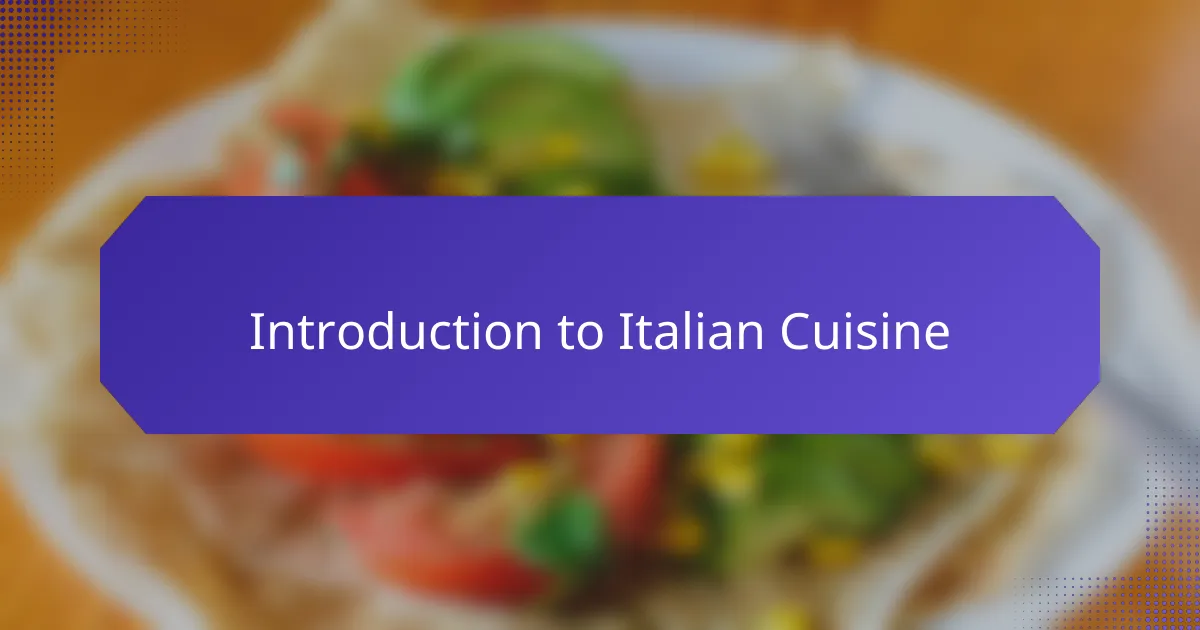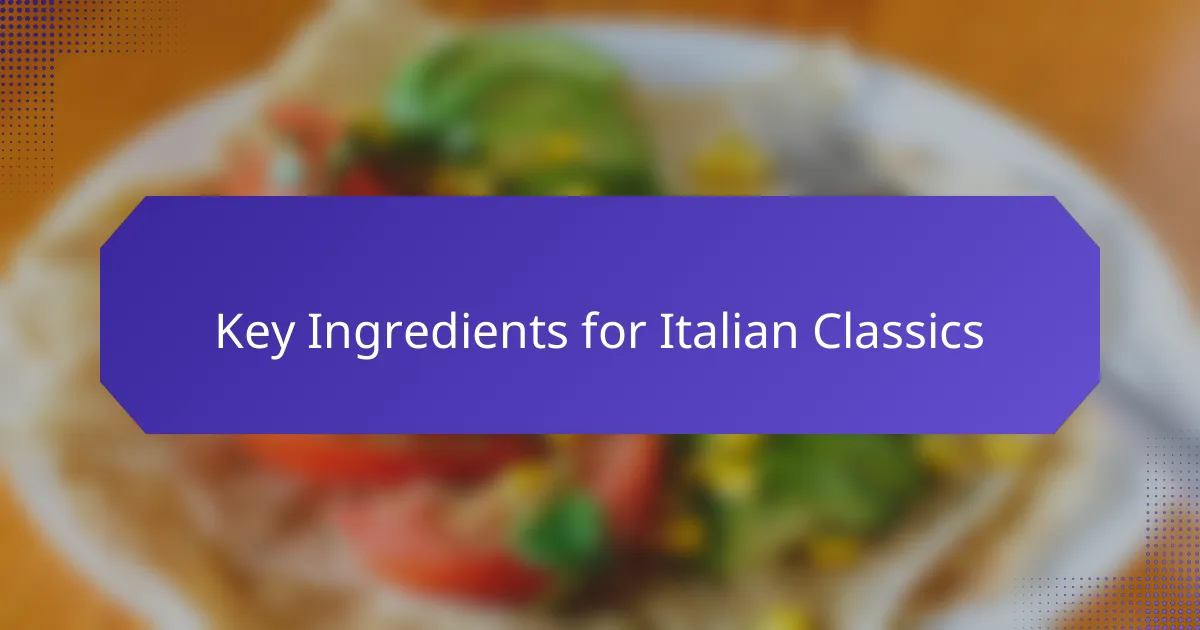Key takeaways
- Italian cooking emphasizes high-quality, seasonal ingredients and simple techniques that allow natural flavors to shine.
- Mastering essential cooking techniques, like blanching and emulsification, enhances both the cooking experience and the final dish.
- Each recipe often evokes personal memories and connections to family traditions, turning cooking into a joyful celebration.
- Notable dishes, like Risotto alla Milanese and Pasta Carbonara, highlight the richness of Italian cuisine and the joy of sharing meals with loved ones.

Cooking Challenge Recipe Overview
When diving into Mario Batali’s Italian classics, I felt an immediate connection to the heart of Italian cooking. Each recipe was like uncovering a story, filled with rich traditions and vibrant flavors. For me, cooking these dishes was not just about following instructions; it was a delightful journey, steeped in nostalgia and the warm comforts of Italy.
As I tackled the recipes, I noticed that every classic, while familiar, presented its unique challenges and rewards. From crafting the perfect risotto to mastering handmade pasta, these dishes required a combination of skill and love. The experience was both fulfilling and sometimes a bit daunting, but each completed dish brought a sense of joy that made the efforts worthwhile.
Here’s a comparison of a few signature recipes that truly stood out during my exploration:
| Recipe | Key Ingredient |
|---|---|
| Risotto alla Milanese | Saffron |
| Pasta Carbonara | Pecorino Romano |
| Osso Buco | Veal Shank |

Introduction to Italian Cuisine
Italian cuisine is a vibrant tapestry of flavors, traditions, and family recipes that have been passed down through generations. When I first delved into Mario Batali’s Italian classics, I was struck by the warmth and simplicity of each dish. Each meal became a celebration, making me feel connected to my roots and the joyful spirit of Italian gatherings.
Exploring the basics of Italian cooking is an adventure in itself. I found it fascinating how fresh ingredients take center stage, with simple preparations that allow their natural flavors to shine. Every time I chopped herbs or stirred a sauce, I felt like I was participating in a centuries-old tradition, which added an extra layer of meaning to my cooking.
- Italian cuisine focuses on high-quality, seasonal ingredients.
- It’s characterized by bold flavors with a focus on simplicity.
- Meals are often a communal experience, emphasizing family and togetherness.
- Traditional dishes, like pasta and risotto, are staples that showcase regional diversity.
- Cooking techniques vary widely, but they all aim to preserve the integrity of the ingredients.

Key Ingredients for Italian Classics
When I think about Italian classics, the first thing that comes to mind is the vibrant ingredients that truly bring these dishes to life. In my own kitchen adventures with Mario Batali’s recipes, I’ve discovered that the quality of your ingredients can make or break a dish. There’s nothing quite like the aroma of fresh basil or the rich, deep flavor of extra virgin olive oil as they mingle in a skillet.
I still remember the first time I used San Marzano tomatoes for a marinara sauce. It was a game changer! The sauce tasted like it came straight from a trattoria in Italy, and it reminded me of my travels. Below are some essential ingredients to have on hand for cooking Italian classics:
- Extra virgin olive oil
- Fresh basil
- San Marzano tomatoes
- Parmigiano-Reggiano cheese
- Fresh garlic
- Arborio rice for risottos
- Imported pasta
- Sea salt
- Fresh or dried oregano
- Capers and olives for added depth

Essential Cooking Techniques
When diving into Mario Batali’s Italian classics, I found that mastering a few essential cooking techniques not only elevated my dishes but also deepened my appreciation for Italian cuisine. Techniques like blanching, sautéing, and making homemade pasta are crucial; they can transform simple ingredients into something extraordinary. For instance, I remember my first attempt at making pasta from scratch—it was messy, but the satisfying taste of fresh fettuccine made it all worthwhile.
Another technique that struck me was the art of emulsification, particularly in dressings and sauces. I learned that a good vinaigrette can make or break a salad, and once I understood how to create that creamy texture, it changed the game for my meals. Cooking is truly an emotional experience, and these techniques help connect you to the food and the culture behind it.
| Technique | Description |
|---|---|
| Blanching | Quickly boiling vegetables, then shocking them in ice water to retain color and texture. |
| Sautéing | Cooking food quickly in a small amount of oil over high heat, enhancing flavor and texture. |
| Making Pasta | Combining flour and eggs, kneading it, and rolling it out for a fresh, homemade taste. |
| Emulsification | Combining two ingredients that don’t normally mix, like oil and vinegar, to create a stable mixture, often used in sauces. |

My Experience with Mario Batali’s Recipes
Diving into Mario Batali’s recipes felt like a culinary adventure for me. His approach to Italian cooking connects traditional techniques with bold flavors, which I found exhilarating. I vividly remember the first time I attempted his classic spaghetti al pomodoro; the freshness of the tomatoes and the simplicity of the dish brought me back to my childhood, reminding me of family gatherings where food was the centerpiece of love and connection.
As I experimented with more of his dishes, I discovered how each recipe told a story. The richness of his osso buco transported me to an Italian kitchen filled with laughter and the aroma of slow-cooked meals. Here’s what I learned during my exploration:
- Simplicity is key; quality ingredients make all the difference.
- Each recipe often requires patience, which is essential for developing deep flavors.
- Cooking can evoke memories, making the experience deeply personal.
- Batali’s emphasis on fresh herbs elevates the dishes in unexpected ways.
- There’s joy in sharing these recipes with friends and family, creating new memories together.

Favorite Recipes from the Challenge
The favorite recipes from my cooking challenge truly showcase the heart and soul of Italian cuisine. Each dish became a personal favorite for its unique characteristics and the memories they evoked. For instance, Risotto alla Milanese, with its luxurious saffron, reminded me of warm family dinners where every bite felt like a warm hug. Have you ever experienced a dish that takes you back in time? That was exactly it for me—each spoonful brought forth feelings of comfort and nostalgia.
Then there was Pasta Carbonara, a recipe that initially intimidated me with its demand for precise timing and technique. However, once I mastered the art of incorporating the Pecorino Romano without scrambling the eggs, I felt a rush of accomplishment. The first time I plated it, I marveled at how something so simple could create such rich flavors. I still remember the satisfying moment when my friends gathered around the table, their faces lighting up with delight at the first taste. It turned cooking into a joyful celebration, amplifying the communal spirit that Italian meals embody.
Lastly, I must mention Osso Buco. Cooking this veal shank dish was a lesson in patience—the long, slow braising process filled my home with mouthwatering aromas that I wished could last forever. Each chop was tender and perfectly complemented by the gremolata I prepared. It wasn’t just dinner; it turned into an experience, a moment where I could appreciate the artistry of Italian cooking. What recipes have left a lasting impact on you? I’d love to hear your stories and see how they resonate with my journey.


